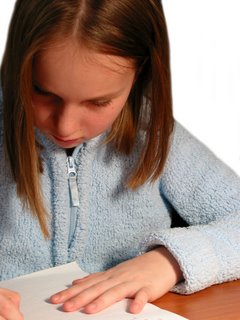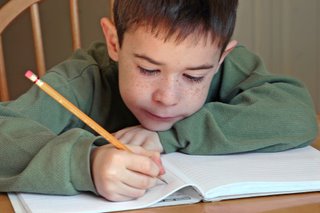Nothing blocks the creative spirit of the writer like an unwanted task. Nearly all of the world’s finest authors have suffered writer’s block at one time or another, and if they have to force themselves through a project in order to meet a deadline, the joy of the process disappears. It’s much better if they take a break from their work and come back to it when inspiration strikes again, as it invariably does.
Children who are forced to undertake ‘creative’ writing when they don’t want to may be able to produce sheets of paper with words on them, but they aren’t experiencing the burst of energy and interest that marks the genuine article. Writers fall in love with the written word because of that thrilling burst, so Montessori instructors need to carefully watch for those moments when children express an interest in putting things down on paper.
 There are several things that can help with this. Organization is key. Materials should be easily found, serviceable and appropriate for the project. A child who is given a beautiful little journal will be inspired to start putting down their thoughts. One who is told that when their short story is finished it will be put into a 3-brad folder, almost like a real book, will enjoy that their efforts are being treated with such respect.
There are several things that can help with this. Organization is key. Materials should be easily found, serviceable and appropriate for the project. A child who is given a beautiful little journal will be inspired to start putting down their thoughts. One who is told that when their short story is finished it will be put into a 3-brad folder, almost like a real book, will enjoy that their efforts are being treated with such respect.
Writing a letter to a relative can be almost as exciting to small children as receiving something in the mail, and, should you have an older student who has taken it upon themselves to write a novel, a trip to the local copy shop can yield a professionally bound manuscript for just a few dollars. Parents and teachers should take time to read what has been written and should offer a critique only when asked to by the child. When young people express that they don’t want anyone else to read what they’ve written, that should be respected, too.
Jane Austen and Charles Dickens are two of the world’s best loved authors. Both of them wrote what they knew about, and it shows in their work. The art of describing one’s feelings and experiences is what one should strive to foster in children, and by encouraging them to write what they know about in their own lives, we assist them in becoming expressive people.
Here are few forms of writing most young people will enjoy exploring:
Letter Writing – This may be a simple thank you note for a gift received, or an informative letter sent to a relative, describing the child’s daily life. Older children might enjoy crafting a sample persuasive letter such as a college application cover letter, or a letter calling for a donation to a favorite charity. This is a wonderful opportunity not only for students to learn about basic forms of address and formatting, but also to develop their own writing voice.
Creative Writing – Children might like to write a story about their own family, and illuminate it with illustrations if they choose. Problem-solving stories of this kind can be especially fun. For example, if there was recently a situation in a child’s life such as a car getting a flat tire, a new baby arriving in the family or a trip to the dentist, the child can become familiar with the format of intro, conflict and resolution by describing the way an event was handled.
There are several ways to help kids start writing a story. Sometimes the first sentence is the hardest. You may want to help them think of an exciting title first (“The Very Strange Day”) and then help them brainstorm about what might happen. If they get stuck, tell them to start the next sentence with “The next day…”. You’d be amazed at how much that helps them move the action along!
 Book Report – A spontaneous book report on a best loved book is not only fun for the students, but also familiarizes them with the art of writing for an imagined audience who knows nothing about the subject. Helping children to learn not to assume that their audience already knows the story will assist them in identifying the key points of something they’ve read in order to convey those to others.
Book Report – A spontaneous book report on a best loved book is not only fun for the students, but also familiarizes them with the art of writing for an imagined audience who knows nothing about the subject. Helping children to learn not to assume that their audience already knows the story will assist them in identifying the key points of something they’ve read in order to convey those to others.
For example, if the student is reading Little House on the Prairie by Laura Ingalls Wilder, is it more relevant to explain that Laura has brown hair, or that her family sets out to cross the country in a covered wagon? Experiments can also be done with book reports wherein, instead of using the first person voice, the writing takes on the form of sales copy by describing why ‘YOU’ the reader will enjoy this book and benefit from reading it.
Writing Dialogue – I never fail to be stunned by the poor dialogue that appears in many modern published books. Characters say things that no one would say in real life! Help your students get over this annoying hurdle by encouraging them to speak their written dialogue aloud, asking themselves the golden question: would someone ever say this? If the words sound natural, chances are they are reflecting true modern speech. If they sound unnatural, the finished work will not be believable.
In its simplest form, dialogue can be written script fashion with names and colons preceding each of the speeches. When encountered in the midst of a narrative, dialogue has its own set of punctuation marks and preferred formatting and students can learn about these when they want their characters to speak.
Journal Writing – Every great author, at some point, got in touch with their personal voice. This is what gives writing a confident, credible tone. I know of no better way for a child to discover this voice than by keeping a diary. It is the practice of frequent journaling that gives rise to comfort in taking up a pen with the self-assurance that clear expression is about to happen. Perhaps one of the most wonderful truths about writing is that voices are as unique as individual people. No voice is ever wrong if it is true to the writer behind it.
Research Paper – Where the subject intrigues the student, research writing is truly rewarding. This might be a report on a foreign country, a science project, a historical event or a local happening. Outlining the subject, describing the most pertinent details associated with it, getting this into a pleasurable, readable format and then correctly citing the sources used in the research are all accomplishments of which students can feel really proud.
Travel writing is the research paper taken to a creative level that makes learning something new truly entertaining for the reader. If your family or class is planning a trip, students can come up with a list of questions they wish to find answers to during the journey. On their return, they can write up their findings into an informative paper. This type of research of a real-life event moves students into the exciting sphere of investigative journalism.
While it’s true that, as adults, we may often have to use our writing skills for tasks that aren’t especially joyful, if our first encounters with writing were pleasant ones, chances are, we can express ourselves with clarity in any given situation. Children who are encouraged to write about what they know and love will pick up the skills of writing well without really noticing it because they are so absorbed in the satisfying effort, and that’s a learning process Maria Montessori would definitely stand up and cheer for!

